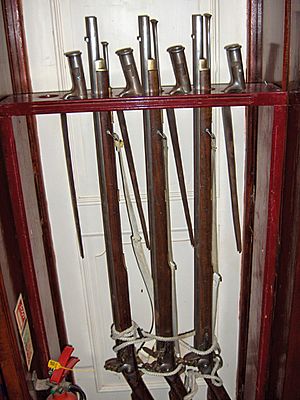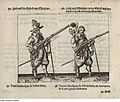Musket facts for kids
A musket was a type of firearm that soldiers used a long time ago. It was fired from the shoulder. To load a musket, you had to put the gunpowder and bullet in from the front end of the barrel. This is called "muzzleloading." Muskets also had a "smoothbore," meaning the inside of the barrel was smooth, not grooved like modern rifles.
Muskets were an important step in weapon history. They replaced an older gun called the arquebus. Later, muskets themselves were replaced by the rifle. The word "musket" can mean a few different kinds of guns:
- A heavy, long gun that needed a stand to rest on. It used a matchlock or wheellock to fire.
- A lighter gun that used a flintlock or percussion cap to fire. These often had a bayonet attached.
Contents
Musketeers and Their Role
Muskets were mainly used by infantry soldiers, who fought on foot. A soldier who carried a musket was called a musketman or musketeer.
In the 1500s, heavy muskets were used alongside arquebusiers (soldiers with arquebuses) and pikemen (soldiers with long spears). By the early 1700s, lighter muskets became more common and took over from the arquebus.
When the bayonet was invented, soldiers could attach a knife to the end of their musket. This meant they didn't need pikemen anymore, as the musket could be used for both shooting and close-up fighting. Soon, almost all infantry soldiers became musketeers.
From Musket to Rifle
The first musket made in the United States was the Springfield Model 1795 Musket. In the 1800s, guns got better. New types of ammunition and ways to fire the gun made it possible to add "rifling" to gun barrels. Rifling means making spiral grooves inside the barrel. This made bullets spin, which helped them fly straighter and hit targets more accurately.
These improved guns were called "rifled muskets." A few years later, new inventions like cartridges (all-in-one bullet packages), "breechloading" (loading from the back of the barrel), and multiple rounds of ammunition led to the modern rifle. After this, muskets were no longer used in armies.
Musket Accuracy and Range
Early smoothbore muskets were not very accurate. If you were shooting at one target, they could only hit it reliably from about 50 to 70 yards (45 to 64 meters) away.
However, rifled muskets from the 1850s were much better. They could hit a person-sized target from up to 500 yards (457 meters) away. This longer range was a big advantage in battles. For example, at the Battle of Four Lakes, soldiers with Springfield Model 1855 rifled muskets could shoot and defeat Native American warriors before they could get close enough with their older smoothbore muskets.
But long range wasn't always enough to win. In the Italian War of 1859, French soldiers were able to beat Austrian forces who had longer-range rifled muskets. The French used quick, small attacks and charged with bayonets at close range, where the longer range of the Austrian guns didn't help as much.
Images for kids
-
Early matchlocks as illustrated in the Baburnama (16th century)
-
An English Civil War manual of the New Model Army showing a part of the steps required to load and fire an earlier musket. The need to complete this difficult and potentially dangerous process as quickly as possible led to the creation of the military drill.
See also
 In Spanish: Mosquete para niños
In Spanish: Mosquete para niños











